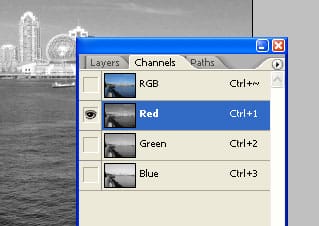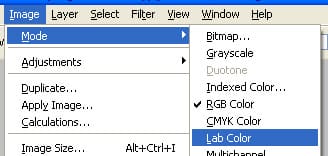Follow this newly discovered method of simulating a polarizing filter with Adobe Photoshop that’s faster, easier, and more effective. Considered the most useful filter in Photography, a polarizing filter makes almost any image look better by absorbing glare to reduce or eliminate reflections and darken skies.
Understanding how this polarizing effect works
Step 1
Download and save the following JPG file to your computer then open it inside Adobe Photoshop.
vancouver.jpg 204.46 Kb (Right mouse click> Save As)
Step 2
Once you have the photo opened inside Adobe Photoshop, look inside the Channels pallet (Window> Channels). Inside the Channels pallet, click on the each of the channels and notice the differences between the channels.

So the red channel’s characteristics are similar to those characteristics of a polarizing filter (reduced reflections and darker blue skies & green vegetation), but how do we apply those characteristics to the image? In the next page, we’ll teach you a fast and effective way of simulating a polarizing filter.
Applying the Polarizing Effect
To apply the characteristics of the red channel into the entire image, we need to replace the luminance of the entire image with the image from the red channel.
Step 3
Open an image you would like to work with or use the vancouver.jpg file we still have opened in Photoshop.

Step 4
Duplicate the current layer (Layer> Duplicate Layer or Ctrl+J).
Step 5
Go in to the Channels pallet (Window> Channels) and click to select the Red channel.

Step 6
With the red channel selected, create a selection of the canvas (Select> All or Ctrl+A) and copy the selection to clipboard (Edit> Copy or Ctrl+C).

Step 7
Before we paste the red channel into the Lightness channel, we need to convert the image into Lab Color (Image> Mode> Lab Color). When it asks “Changing modes can affect the appearance of layers. Flatten image before mode change?”, select Don’t Flatten.

Step 8
Go in to the Channels pallet (Window> Channels) and click to select the Lightness channel.

Step 9
Paste (Ctrl+V) the red channel that you have copied in your clipboard. The Lightness channel should be replaced with the image from the Red channel.
2 responses to “Polarizing Filter”
-
Thanks. This was really helpful!
-
As I now have to upgrade my photo processing software on some of my older computers, I’m surprised to find that on the latest versions of Photoshop, you have to go through a 13 step process. With older versions of PS, there were plugin filters that would apply a polarizing effect with the press of a button. If you want to vary the amount of polarization, just make a duplicate copy of the layer and use the opacity slider. Done in 2 steps.


Leave a Reply